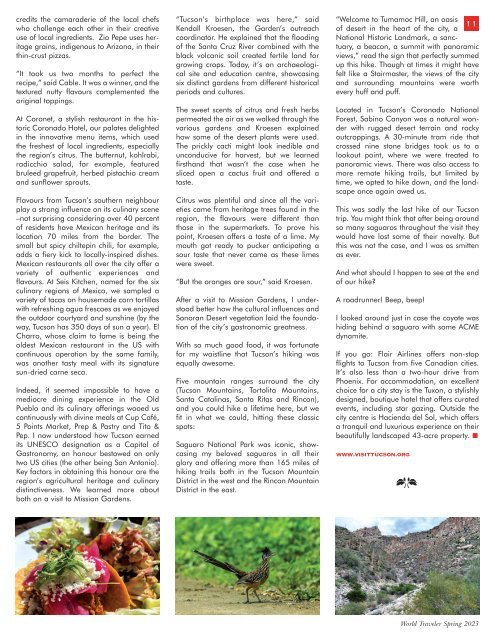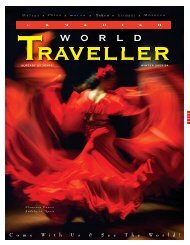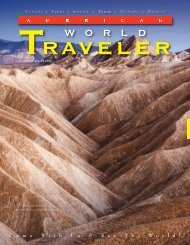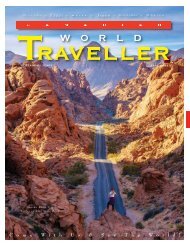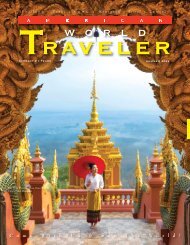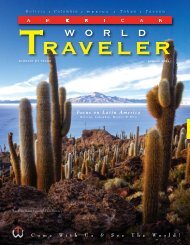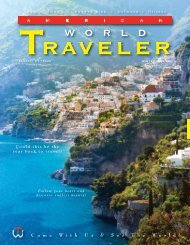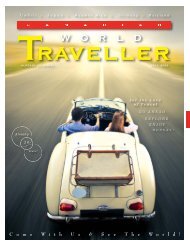Canadian World Traveller Spring 2023 Issue
Now in our 21st year of publishing, Canadian World Traveller explores the culture and history of worldwide destinations, sharing the adventure of discovery with our readers and motivating them to make their travel dreams a reality. Published quarterly, CWT helps sophisticated, independent Canadian travellers choose their next destination by offering a lively blend of intelligent, informative articles and tantalizing photographic images from our World’s best destinations, cruises, accommodations and activities to suit every traveller's taste.
Now in our 21st year of publishing, Canadian World Traveller explores the culture and history of worldwide destinations, sharing the adventure of discovery with our readers and motivating them to make their travel dreams a reality. Published quarterly, CWT helps sophisticated, independent Canadian travellers choose their next destination by offering a lively blend of intelligent, informative articles and tantalizing photographic images from our World’s best destinations, cruises, accommodations and activities to suit every traveller's taste.
You also want an ePaper? Increase the reach of your titles
YUMPU automatically turns print PDFs into web optimized ePapers that Google loves.
credits the camaraderie of the local chefs<br />
who challenge each other in their creative<br />
use of local ingredients. Zio Pepe uses heritage<br />
grains, indigenous to Arizona, in their<br />
thin-crust pizzas.<br />
“It took us two months to perfect the<br />
recipe,” said Cable. It was a winner, and the<br />
textured nutty flavours complemented the<br />
original toppings.<br />
At Coronet, a stylish restaurant in the historic<br />
Coronado Hotel, our palates delighted<br />
in the innovative menu items, which used<br />
the freshest of local ingredients, especially<br />
the region’s citrus. The butternut, kohlrabi,<br />
radicchio salad, for example, featured<br />
bruleed grapefruit, herbed pistachio cream<br />
and sunflower sprouts.<br />
Flavours from Tucson’s southern neighbour<br />
play a strong influence on its culinary scene<br />
–not surprising considering over 40 percent<br />
of residents have Mexican heritage and its<br />
location 70 miles from the border. The<br />
small but spicy chiltepin chili, for example,<br />
adds a fiery kick to locally-inspired dishes.<br />
Mexican restaurants all over the city offer a<br />
variety of authentic experiences and<br />
flavours. At Seis Kitchen, named for the six<br />
culinary regions of Mexico, we sampled a<br />
variety of tacos on housemade corn tortillas<br />
with refreshing agua frescoes as we enjoyed<br />
the outdoor courtyard and sunshine (by the<br />
way, Tucson has 350 days of sun a year). El<br />
Charro, whose claim to fame is being the<br />
oldest Mexican restaurant in the US with<br />
continuous operation by the same family,<br />
was another tasty meal with its signature<br />
sun-dried carne seca.<br />
Indeed, it seemed impossible to have a<br />
mediocre dining experience in the Old<br />
Pueblo and its culinary offerings wooed us<br />
continuously with divine meals at Cup Café,<br />
5 Points Market, Prep & Pastry and Tito &<br />
Pep. I now understood how Tucson earned<br />
its UNESCO designation as a Capital of<br />
Gastronomy, an honour bestowed on only<br />
two US cities (the other being San Antonio).<br />
Key factors in obtaining this honour are the<br />
region’s agricultural heritage and culinary<br />
distinctiveness. We learned more about<br />
both on a visit to Mission Gardens.<br />
“Tucson’s birthplace was here,” said<br />
Kendall Kroesen, the Garden’s outreach<br />
coordinator. He explained that the flooding<br />
of the Santa Cruz River combined with the<br />
black volcanic soil created fertile land for<br />
growing crops. Today, it’s an archaeological<br />
site and education centre, showcasing<br />
six distinct gardens from different historical<br />
periods and cultures.<br />
The sweet scents of citrus and fresh herbs<br />
permeated the air as we walked through the<br />
various gardens and Kroesen explained<br />
how some of the desert plants were used.<br />
The prickly cacti might look inedible and<br />
unconducive for harvest, but we learned<br />
firsthand that wasn’t the case when he<br />
sliced open a cactus fruit and offered a<br />
taste.<br />
Citrus was plentiful and since all the varieties<br />
came from heritage trees found in the<br />
region, the flavours were different than<br />
those in the supermarkets. To prove his<br />
point, Kroesen offers a taste of a lime. My<br />
mouth got ready to pucker anticipating a<br />
sour taste that never came as these limes<br />
were sweet.<br />
“But the oranges are sour,” said Kroesen.<br />
After a visit to Mission Gardens, I understood<br />
better how the cultural influences and<br />
Sonoran Desert vegetation laid the foundation<br />
of the city’s gastronomic greatness.<br />
With so much good food, it was fortunate<br />
for my waistline that Tucson’s hiking was<br />
equally awesome.<br />
Five mountain ranges surround the city<br />
(Tucson Mountains, Tortolita Mountains,<br />
Santa Catalinas, Santa Ritas and Rincon),<br />
and you could hike a lifetime here, but we<br />
fit in what we could, hitting these classic<br />
spots:<br />
“Welcome to Tumamoc Hill, an oasis<br />
11<br />
of desert in the heart of the city, a<br />
National Historic Landmark, a sanctuary,<br />
a beacon, a summit with panoramic<br />
views,” read the sign that perfectly summed<br />
up this hike. Though at times it might have<br />
felt like a Stairmaster, the views of the city<br />
and surrounding mountains were worth<br />
every huff and puff.<br />
Located in Tucson’s Coronado National<br />
Forest, Sabino Canyon was a natural wonder<br />
with rugged desert terrain and rocky<br />
outcroppings. A 30-minute tram ride that<br />
crossed nine stone bridges took us to a<br />
lookout point, where we were treated to<br />
panoramic views. There was also access to<br />
more remote hiking trails, but limited by<br />
time, we opted to hike down, and the landscape<br />
once again awed us.<br />
This was sadly the last hike of our Tucson<br />
trip. You might think that after being around<br />
so many saguaros throughout the visit they<br />
would have lost some of their novelty. But<br />
this was not the case, and I was as smitten<br />
as ever.<br />
And what should I happen to see at the end<br />
of our hike?<br />
A roadrunner! Beep, beep!<br />
I looked around just in case the coyote was<br />
hiding behind a saguaro with some ACME<br />
dynamite.<br />
If you go: Flair Airlines offers non-stop<br />
flights to Tucson from five <strong>Canadian</strong> cities.<br />
It’s also less than a two-hour drive from<br />
Phoenix. For accommodation, an excellent<br />
choice for a city stay is the Tuxon, a stylishly<br />
designed, boutique hotel that offers curated<br />
events, including star gazing. Outside the<br />
city centre is Hacienda del Sol, which offers<br />
a tranquil and luxurious experience on their<br />
beautifully landscaped 43-acre property.<br />
Saguaro National Park was iconic, showcasing<br />
my beloved saguaros in all their www.visittucson.org<br />
glory and offering more than 165 miles of<br />
hiking trails both in the Tucson Mountain<br />
District in the west and the Rincon Mountain<br />
34<br />
District in the east.<br />
<strong>World</strong> Traveler <strong>Spring</strong> <strong>2023</strong>


